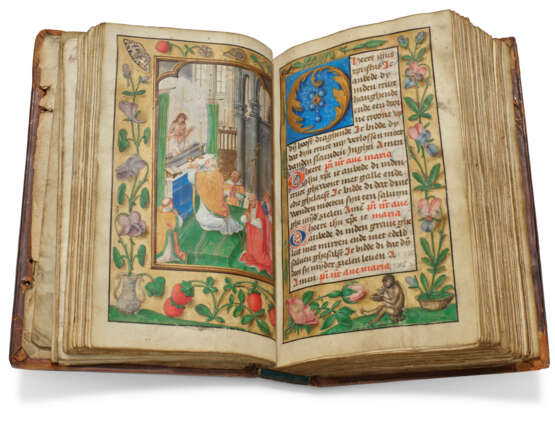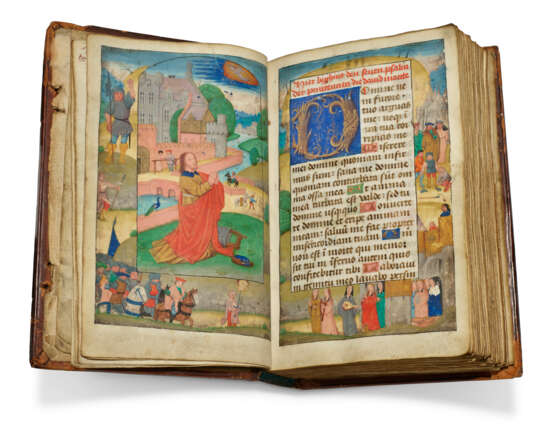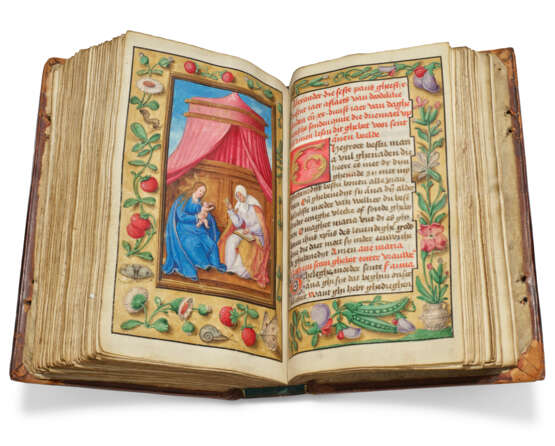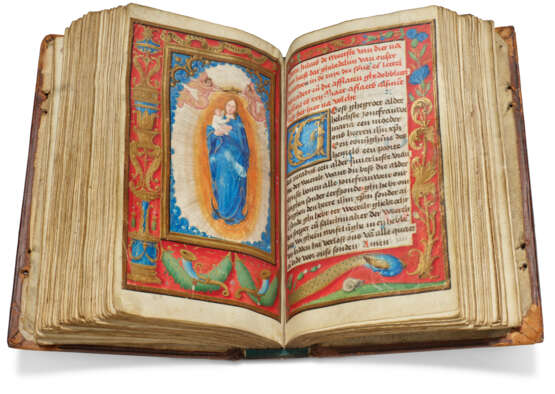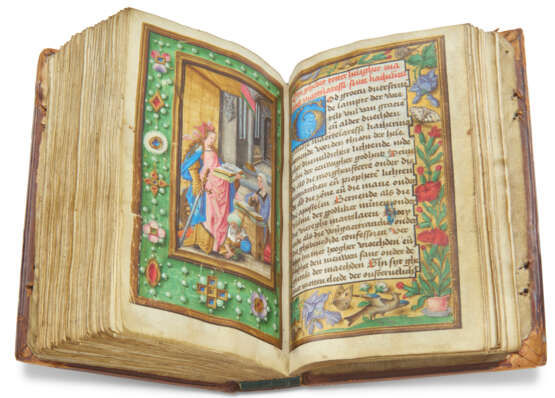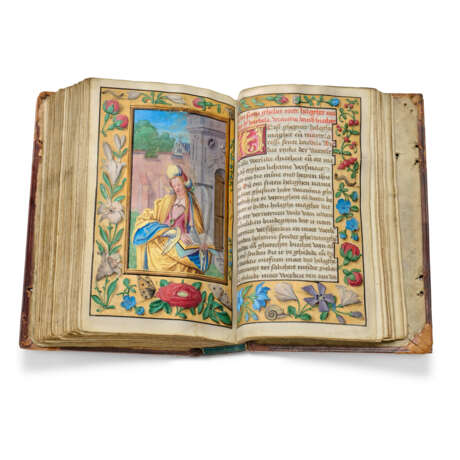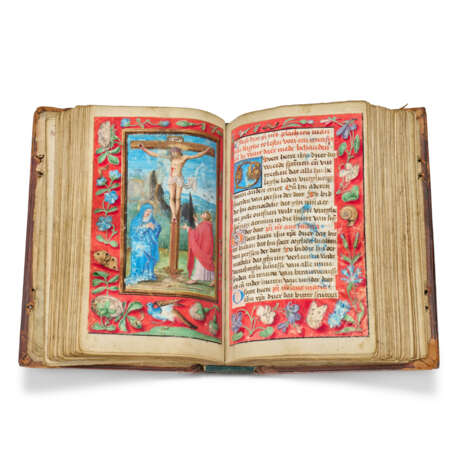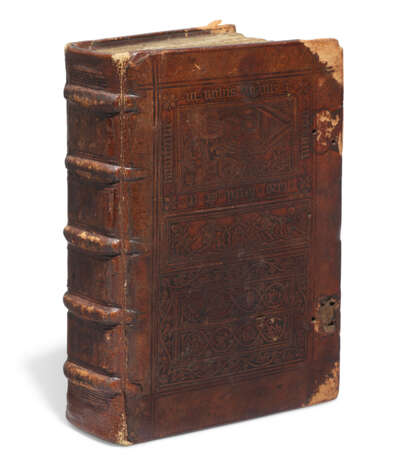ID 1249775
Lot 38 | Associate of the Master of Cardinal Wolsey and anonymous Ghent-Bruges illuminator
Estimate value
£ 50 000 – 80 000
Prayerbook, in Dutch with some Latin, illuminated manuscript on vellum [southern Netherlands, probably Antwerp, c.1524]
A fascinating luxury prayerbook in its original binding, custom-made for a prestigious female patron at the height of the Flemish Renaissance, combining the achievements of Ghent-Bruges illumination with the mannerist style prevalent in Antwerp, influenced by the great panel painters of the early 16th century.
165 x 110mm. ii + 160 + ii leaves, apparently complete, 22 lines, ruled space: 113 x 68mm, some guide letters visible in lower corners, rubrics in red, Psalms with one-line initials in gold or coloured grounds, two to four-line decorated penwork initials in blue or red with contrasting flourishing, seven large initials in gold of acanthus or stems with infills of flowers or gems, with full borders, seven large miniatures with corresponding full-page borders, including one historiated (some signs of wear or rubbing, a few areas of dampstaining with smudging or offsetting affecting some miniatures, most notably on f.61v and f.98v, minor cockling to border of f.132v, small area of browning to a few text leaves). Original calf binding over wooden boards, blind-stamped on both covers with panels of the Nativity bordered with the words `In verbum caro factum est et habitavit in nobis ioannis’, a central frieze of dancing peasants, one playing the bagpipes and a panel with two rows of animals within vine scrolls (joints restored, some wear including traces of original clasps and corner mounts, small wormhole to upper cover).
Provenance:
(1) The sparse calendar contains saints venerated in the southern Netherlands. The female patron for whom the manuscript was made is seen kneeling in prayer at a prie-dieu on f.132v before St Catherine, most likely her namesake. There is an emphasis on female saints throughout and amongst those in the litany are Sts Anne, Elizabeth and Monica, perhaps reflecting her status as a married woman or mother. The majority of the prayers are in Dutch, although, customary for the southern Netherlands, prayers in Latin are also included. The manuscript comprises an individualized compilation of devotions, tailored to the individual needs of the owner, with explanatory rubrics in Dutch highlighting their significance.
Two panels stamped on the binding, of the dancing figures and animals including a stag, dog, squirrel, hare, boar and monkey within vine scrolls, are similar to those on bindings attributed to Ludovicus Bloc, documented in Bruges 1484-1529, cf. E.P. Goldschmidt, Gothic and Renaissance Bookbindings, London, 1928, no. 107, plate XLII; see also Syracuse University Library, Department of Special Collections, MS 7 and the de Croy Hours, Vienna, Österreichische Nationalbibliothek, Cod. 1858.
(2) family records in Dutch inscribed on two blank leaves at end, listing the births of 11 children between 1557 and 1575, their names given with those of their godparents, some with professions (‘coffremaker’). Although not firmly identifiable, family names are typical of those recorded in 16th-century Antwerp and Brussels, one godfather Jacob Van Hinxthoven sharing the name of the Master of the Antwerp mint (1562-1572) and another, François Guebels, familiar from the great tapestry workshop in Brussels.
(3) Ullens / Ullens de Schooten armorial bookplate pasted inside upper cover, engraved in 1698 by Jan Baptist Berterham (active 1687-1722, printmaker active in Brussels). Charles II of Spain elevated three members of the Ullens family to the hereditary nobility in the southern Netherlands in 1693.
(4) Dr Henry Nazeby Harrington (1862-1934), two bookplates pasted inside lower cover, one etched by David Young Cameron, dated 1911.
(5) Sold at Christie's, 24 June 1992, lot 62.
(6) Antiquariaat Forum, 1994, Catalogue 102, no 2.
Content:
i-ii added Short Hours of the Passion; calendar ff.1-6; ruled blank f.7; Seven Penitential Psalms f.9-20; Gospel extracts in Latin, repeated in Dutch ff.20v-22v; prayers to the Holy Ghost and Virgin and for protection against pestilence ff.23-25v; prayers to be said in tribulation ff.25v-f.27; rubric for indulgenced prayers to be said before the Instruments of the Passion f.27v; indulgenced prayers to Christ on the Cross and others including St Calixtus ff.29-33; Eight verses to St Bernard, followed by indulgenced prayers and those to be said when going to sleep and at the point of death ff.33v-49v; the Seven Hours recited by Mary Magdalene in the wilderness and prayers on the Passion ff.49v-60v; prayer to be said before the Crucifix f.62-62v; St Denis on the passion followed by prayers for Holy Communion, prayers for a good life, for easing the suffering of the dead ff.62v-97; Pope Julius II’s indulgenced prayer to Our Lady in the rays of the sun ff.99-100; indulgenced prayers, 72 names of the Virgin Mary and prayers for mothers ff.100-112; Seven sorrows of the Virgin ff.112v-118v; Pope Alexander VI’s indulgenced prayer, prayers to St Anne and for protection from pestilence ff.120-131v; prayer to St Catherine, with suffrages to Agatha, Barbara, Apollonia, Mary Magdalene, Elizabeth, Inghel ff.133-138v; ruled blank f.139; St Augustin’s four teachings on the words of Solomon, prayers for when approaching death ff.140-155v; Seven Joys of the Virgin added in a near-contemporary hand ff.156-160v.
The prayers are tailored to the devotional needs of the owner, Catherine, giving an insight into her daily rituals and concerns, with many indulgenced prayers to ensure her protection and salvation. There is a careful linking of text and image; when she held this prayerbook open, for example, with the miniature of the Crucifixion before her, the rubric instructed her to recite the prayer on the facing page every day before a Crucifix. Instructions for the prayer to be said before the Instruments of the Passion are placed with the miniature of the Mass of St Gregory, a popular devotion rewarded by a large number of indulgences, doubled by Pope Julius II. Pope Alexander VI’s prayer accompanying the miniature of the Virgin and Child with St Anne, would have gained the owner 10,000 years of indulgences if said three times on her knees before an image of St Anne.
Illumination:
The illusionistic borders and various stylistic features in the miniatures link the illumination to manuscripts produced in Bruges and Ghent in the early decades of the 16th century. However, this custom-made prayerbook is likely to have been made in Antwerp, where some of the characteristics of Mannerist painting of the Italian High Renaissance had begun to influence Flemish illuminators. Most of the miniatures are in the style associated with the Master of Cardinal Wolsey, whose known manuscripts, and those of his associates, are likely to date to the decade 1520-30. The style is characterised by elongated figures, voluminous drapery and exaggerated gestures, seen particularly in the theatrical pose of St Barbara (f.134v). There are strong stylistic links to two of three known manuscripts commissioned by Marcus Cruyt (d.1536), Abbot of St-Bernard-sur-l’Escaut in Hemiksem near Antwerp, from the Leuven scribe Francis Weert (active c.1520-39), illuminated by associates of the Master of Cardinal Wolsey. One is the Manual Pietatis or Libellus Oratorium (Bornem, Sint-Bernardusabdij, Ms. 9), a prayerbook for Cruyt’s own personal use, where the opening miniature on f.1v shows Cruyt before the Virgin lactans in front of a portico, a composition based on an engraving dated 1524 by the Antwerp artist Dirk Jacobsz Vellert (see M. Smeyers and J. van der Stock eds, Flemish Illuminated Manuscripts 1475-1550, 1996, p.151). A distinctive architectural motif devised by the artist (not appearing in the engraving) of repeated roundels on the portico, appears too on St Barbara’s tower on f.134v of the present manuscript. The text leaves and illusionistic borders in both manuscripts bear such close comparison that they must have been produced in the same workshop. Common to both are the heavy outlining around script which extends beyond the text block, the rendering of snails, butterflies, flowers and fruit and particular motifs such as the chained monkey clutching a swaddled kitten (here, f.29) and individual gems in the jewelled border surrounding the St Catherine miniature, almost identical to f.53 in the Bornem manuscript (reproduced in Maurits Smeyers, Flemish Miniatures, Leuven, 1999, p.419).
The Crucifixion miniature in Catherine’s prayerbook is based on the monumental miniature on f.68v of the Arenberg Missal, also commissioned by Cruyt and illuminated by the so-called Associate of the Master of Cardinal Wolsey shortly after 1524. The artist drew upon a number of sources including Dürer and Joos van Cleve, integrating them successfully to create a miniature with the grandeur of a panel painting (T. Kren and S. McKendrick, Illuminating the Renaissance: The Triumph of Flemish Manuscript Painting in Europe, 2003, cat. 170, private collection). Although the artist of the present manuscript has omitted the figure of Mary Magdalene at the foot of the Cross, many elements of the composition and stylistic devices are skilfully reproduced.
The miniature of David Praying (f.8v-9) differs in style and was probably produced from a workshop in Bruges or Ghent. It draws upon the rich legacy of patterns which had evolved there from the 1470s onwards, shared, transmitted and renewed by the following generations of illuminators. David’s pose and immediate setting derive from a miniature by the Master of the Houghton Miniatures, c.1480, which shows the king kneeling in a garden before his monumental palace (see T. Kren, ‘The importance of patterns in the emergence of a new style of Flemish manuscript illumination after 1470’, Manuscripts in Transition. Recycling Manuscripts, Texts and Images, B. Dekeyzer and J. van der Stock eds, 2005, pp. 363-4). The image is also close to the David miniature in the Manderscheid Hours associated with the Master of the David Scenes in the Grimani Breviary (Renate König collection, cited in T. Kren & S. McKendrick, Illuminating the Renaissance, p.384, n.10), produced in his more mature style in the years approaching 1510. It is likely that Gerard Horenbout (active 1487-c.1540) was the source for the integration of border and miniature into one scene (see, for example, the Book of Hours of Charles V, sold in these rooms, 23 April 2021, lot 16, f.119v). The narrative scenes, which extend across the double-page opening, are very similar in composition and layout to the David miniature by the Master of the Lübeck Bible in the Spinola Hours, Ghent and Bruges, c.1510-20, one of the greatest manuscripts of the period (Los Angeles, The J. Paul Getty Museum, Ms. Ludwig IX 18, f.166). Many elements have been carefully reproduced, including the pose of Goliath, the children arming the young David, the white horse with blue trappings and even a bird and three small figures sketched on top of the hill, referencing the finished equivalents in the Spinola miniature.
The miniature of The Mass of St Gregory is also based on a model which evolved in Bruges and Ghent, although the miniature may have been produced in Antwerp. The composition appeared in various styles throughout the period and is close to a model used by the workshop of Gerard Horenbout, in the Hours of Charles V (referenced above), itself derived from a model connected with the Vienna Master of Mary of Burgundy in the Voustre demeure Hours, Berlin, Kupferstichkabinett, ms 78 B 13, f.15.
A richness is brought to this prayerbook by the classicised and jewelled borders on red or green grounds recalling the luxurious borders favoured by Simon Bening (see The Arcana Collection, sold in these rooms, 7 July 2010, lot 46 and the da Costa Hours, New York, The Morgan Library, MS. M.399). A hallmark of Ghent-Bruges illumination, the naturalistic flowers, insects, peacocks and gems recall the taste for splendour and display at the court of the dukes of Burgundy, emulated in manuscripts made for wealthy patrons.
The subjects of the miniatures are:
David praying, scenes in the border showing Goliath and the boy David returning triumphant with Goliath’s head leading Saul’s procession, the facing border with women emerging from a castle playing musical instruments to greet him, children putting armour on the young David f.8v-9; Mass of St Gregory f.28v; Crucifixion f.61v; Virgin and Child as the Woman of the Apocalypse, clothed in the rays of the sun standing on the crescent moon f.98v; Virgin and Child with St Anne f.119v; female patron in prayer kneeling at a prie-dieu before St Catherine with Emperor Maxentius at her feet f.132v; St Barbara f.134v.
| Place of origin: | Western Europe, Europe, The Netherlands |
|---|---|
| Auction house category: | Medieval & renaissance manuscripts, Books and manuscripts |
| Place of origin: | Western Europe, Europe, The Netherlands |
|---|---|
| Auction house category: | Medieval & renaissance manuscripts, Books and manuscripts |
| Address of auction |
CHRISTIE'S 8 King Street, St. James's SW1Y 6QT London United Kingdom | |
|---|---|---|
| Preview |
| |
| Phone | +44 (0)20 7839 9060 | |
| Buyer Premium | see on Website | |
| Conditions of purchase | Conditions of purchase |
